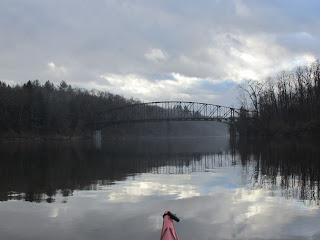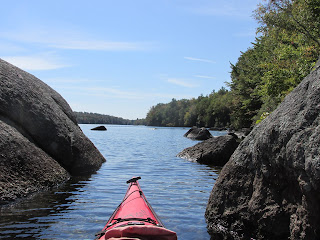Convergence Points on the Connecticut
New Years Day 2019 and I'd just launched from Pauchaug Brook Access in Northfield, MA. Skies were fickle, temperatures above normal, and gusty winds from the W/NW predicted. Before turning about and heading up the Connecticut River's west shore, I looked to the south and the Schell Bridge. It was from that direction that 2 canoes were being hurriedly paddled upriver in the pre-dawn hours way back in July 1698. The four Native American men paddling had conducted a late-day raid on some English farmers more than 20 miles downriver in Hatfield North Meadow. They'd killed 2 men and taken 2 boys, 11 year old Samuel Dickinson and a lad known only as Charley, captive during the raid. The captives were spirited to canoes hidden by the river and the long journey to possibly Canada began. Perhaps holding them for ransom was their motive but we'll never know for sure. In darkness they'd made what must have been a difficult portage of the great falls at Peskeompskut before paddling all those miles against the river's current. Little did they know, however, their journey was going to be violently disrupted in another 4 miles. When news of the raid had reached Deerfield, a hastily-assembled group of 14 Englishmen on horseback were dispatched on a rescue mission. They spent the night galloping northward along the river's west side. My destination was the very place where both groups converged the following morning.
Since I'd be hugging the river's west shore, and in honor of it being New Years Day, I stopped at the riverbank spot where 3 states converge; Massachusetts, New Hampshire, and Vermont...
Found the gps coordinates for the above boundary marker on the waymarking.com web site. Another even larger monument known as the Mud Turtle once served as the marker but has been submerged beneath the water for many years.
After passing the old abandoned railroad bridge abutments...
...and some swirling currents around the diminutive Rock Island, I approached the scene of the fateful 1698 convergence...
It's an island that was once said to be 12 acres in size but over time has been whittled away to only a fraction of that. I paddled along the island's eastern shore noticing this dead bald eagle...
...along the way. As I neared the island's northern tip the sound of a gun shot pierced the the air from a hunter's gun I assume.
The 4 Native American paddlers must have been exhausted as they reached this same spot having covered more than 25 miles through the night. Hiding on the river's west shore were the 14 Englishmen who'd reached a spot upstream of the island. The events which subsequently unfolded determined the name the island would bear for many years to come.
Historians Josiah H. Temple and George Sheldon told the story in their 1875 A History of the town of Northfield, Massachusett, for 150 years...: "In the early dawn they (rescue party) discovered two canoes in the distance, rapidly ascending along the eastern bank. Selecting a position on some broken land close to the water, they waited till the canoes appeared above the island, and opposite where they stood, when taking careful aim, they fired, one of the Indians was mortally wounded; but with the other three and one of the lads leaped into the stream and made for the shore. One lad remained in the canoe, and the other quickly turned to rejoin him. An Indian, noticing the movement, attempted to shoot him: but his gun missed fire, and he rushed upon the boy with uplifted hatchet. In this act he exposed himself so that he received a mortal shot from the party on the west bank. The boys, both unhurt, quickly paddled across to their deliverers."
The story should have stopped there with the rescuers having achieved their objective...but, unfortunately, it didn't.
With the rescue party now having one of the canoes in their possession and seeing the other canoe beached at the island's northern tip, someone decided that getting the beached canoe would allow them to pursue the remaining 2 Indians. So 5 or 6 men got into the canoe and paddled over to the island where they were caught by surprise when one of the surviving Indians stood amidst the tall grass and shot one of their party, a young man named Nathaniel Pomeroy of Deerfield. "They made his lonely grave on the west bank of the river; but his memorial is the island where he fell - which is called Pomeroy's island unto this day."
Brings to my mind numerous old sayings such as "don't press your luck", "quit while your ahead", "leave well enough alone", etc, etc.
I landed at the island's northern tip...
...probably not too far from where the Native Americans were hiding in the tall grass and where Nathaniel Pomeroy fell.
All but the highest parts of the island were coated with a recent deposit of Connecticut River mud which is as slippery a mud as I've seen. Where someone built a work table of sorts, perhaps to support camping, a heavy layer of muck coats the ground...
...while just a ways from there was this area ideal for the pitching of tents...
Pomeroy's island is located about a quarter mile down river from the mouth of the Ashuelot River.
The trip back down to Pauchaug included this sky of contrasts...
...more eagle sightings such as this one enjoying lunch...
...and some gathered-up plastic including a small stuffed alien...
When driving away from the boat access I noticed another monument almost immediately across the road and wondered if this unfortunate man was related to the 11 year old captive Samuel Dickinson...
Upon returning home and checking the website Geni.com I found that Nathaniel Dickinson was actually the younger brother of Samuel. Nathaniel was born 4 months after Samuel's brief captivity and memorable canoe trip. Oddly enough Samuel lived to the age of 73.
Since I'd be hugging the river's west shore, and in honor of it being New Years Day, I stopped at the riverbank spot where 3 states converge; Massachusetts, New Hampshire, and Vermont...
Found the gps coordinates for the above boundary marker on the waymarking.com web site. Another even larger monument known as the Mud Turtle once served as the marker but has been submerged beneath the water for many years.
After passing the old abandoned railroad bridge abutments...
...and some swirling currents around the diminutive Rock Island, I approached the scene of the fateful 1698 convergence...
It's an island that was once said to be 12 acres in size but over time has been whittled away to only a fraction of that. I paddled along the island's eastern shore noticing this dead bald eagle...
...along the way. As I neared the island's northern tip the sound of a gun shot pierced the the air from a hunter's gun I assume.
The 4 Native American paddlers must have been exhausted as they reached this same spot having covered more than 25 miles through the night. Hiding on the river's west shore were the 14 Englishmen who'd reached a spot upstream of the island. The events which subsequently unfolded determined the name the island would bear for many years to come.
Historians Josiah H. Temple and George Sheldon told the story in their 1875 A History of the town of Northfield, Massachusett, for 150 years...: "In the early dawn they (rescue party) discovered two canoes in the distance, rapidly ascending along the eastern bank. Selecting a position on some broken land close to the water, they waited till the canoes appeared above the island, and opposite where they stood, when taking careful aim, they fired, one of the Indians was mortally wounded; but with the other three and one of the lads leaped into the stream and made for the shore. One lad remained in the canoe, and the other quickly turned to rejoin him. An Indian, noticing the movement, attempted to shoot him: but his gun missed fire, and he rushed upon the boy with uplifted hatchet. In this act he exposed himself so that he received a mortal shot from the party on the west bank. The boys, both unhurt, quickly paddled across to their deliverers."
The story should have stopped there with the rescuers having achieved their objective...but, unfortunately, it didn't.
With the rescue party now having one of the canoes in their possession and seeing the other canoe beached at the island's northern tip, someone decided that getting the beached canoe would allow them to pursue the remaining 2 Indians. So 5 or 6 men got into the canoe and paddled over to the island where they were caught by surprise when one of the surviving Indians stood amidst the tall grass and shot one of their party, a young man named Nathaniel Pomeroy of Deerfield. "They made his lonely grave on the west bank of the river; but his memorial is the island where he fell - which is called Pomeroy's island unto this day."
Brings to my mind numerous old sayings such as "don't press your luck", "quit while your ahead", "leave well enough alone", etc, etc.
I landed at the island's northern tip...
...probably not too far from where the Native Americans were hiding in the tall grass and where Nathaniel Pomeroy fell.
All but the highest parts of the island were coated with a recent deposit of Connecticut River mud which is as slippery a mud as I've seen. Where someone built a work table of sorts, perhaps to support camping, a heavy layer of muck coats the ground...
...while just a ways from there was this area ideal for the pitching of tents...
Pomeroy's island is located about a quarter mile down river from the mouth of the Ashuelot River.
The trip back down to Pauchaug included this sky of contrasts...
...more eagle sightings such as this one enjoying lunch...
...and some gathered-up plastic including a small stuffed alien...
When driving away from the boat access I noticed another monument almost immediately across the road and wondered if this unfortunate man was related to the 11 year old captive Samuel Dickinson...
Upon returning home and checking the website Geni.com I found that Nathaniel Dickinson was actually the younger brother of Samuel. Nathaniel was born 4 months after Samuel's brief captivity and memorable canoe trip. Oddly enough Samuel lived to the age of 73.















Comments
Post a Comment